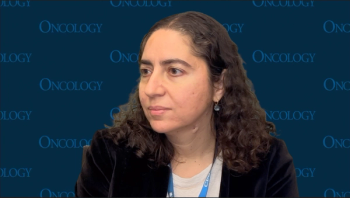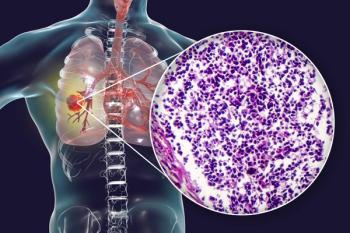
Novel Targeted Therapy Shows Promise in PSMA-Positive Prostate Cancer
225Ac-LNC1011 targeted α therapy elicited an ORR of 50.0% in patients with PSMA-positive prostate cancer in a phase 1 trial.
The use of 225Ac-LNC1011 targeted α therapy (TAT) demonstrated favorable efficacy and an acceptable toxicity profile in a small cohort of patients with prostate-specific membrane antigen (PSMA)–positive prostate cancer, according to results from a phase 1 trial (ChiCTR2500095162) shared at the
According to RECIST v1.1 criteria, the objective response rate (ORR) was 50%, with 2 patients achieving partial responses (PRs) and 2 patients having stable disease. According to PERCIST v1.0 guidelines, the ORR was 75%, with 3 patients achieving PRs and 1 having stable disease. The imaging from baseline and the last follow-up were used for the efficacy evaluation.
Following treatment, prostate-specific antigen (PSA) levels decreased in all patients. The levels went from 7.885 ng/mL to 0.185 ng/mL; from 6.034 ng/mL to 1.016 ng/mL; from 353.395 ng/mL to 310.238 ng/mL; and from 13.062 ng/mL to 1.057 ng/mL.
The median progression-free survival (PFS), with follow-up times of 12 months, 12 months, 6 months, and 6 months, were all yet to be reached. Of the four patients, their respective ECOG performance statuses at baseline were 1, 2, 2, and 2; after treatment, they were 0, 1, 3, and 1.
It was noted that the third patient developed a respiratory infection and experienced a progressive decline in their general condition. In March 2025, the patient died, and the death was not considered to be related to 225Ac-LNC1011.
“225Ac-LNC1011 TAT showed a favorable ORR and acceptable toxicity profile, making it a promising potential treatment for PSMA-positive prostate cancer,” wrote lead study author Huipan Liu, of the Department of Nuclear Medicine at The Affiliated Hospital of Southwest Medical University, of Nuclear Medicine and Molecular Imaging Key Laboratory of Sichuan Province, and of the Institute of Nuclear Medicine at Southwest Medical University in China, with coauthors in the presentation. “Further studies are currently underway to measure both the safety and efficacy of the treatment, as well as to determine the optimal dose and dose interval.”
The trial initially enrolled 3 patients at dose level 1 (100 µCi). The escalation scheme planned to proceed to the next dose level if there were no dose-limiting toxicities (DLTs) in these 3 patients; if there was 1 DLT in 3 patients, they would expand the cohort to 6 patients; if there was 1 or fewer DLTs in 6 patients, they would escalate; and if there were 2 or more DLTs in 3 to 6 patients, they would declare the maximum tolerable dose (MTD) reached.
Eligible patients were 18 years or older with a histologic, pathologic, and/or cytologic diagnosis of prostate cancer with PSMA positivity confirmed by baseline 68Ga-PSMA PET/CT imaging. Additionally, patients had an ECOG performance status of 2 or less; adequate bone marrow, liver and renal function; and no pre-existing toxicities greater than NCI-CTCAE v5.0 grade 0 or 1.
The objective of the study was to evaluate the MTD, safety, and efficacy of 225Ac-LNC1011 TAT. Furthermore, they were to assess the ORR and PFS in patients with metastatic castration-resistant prostate cancer, to evaluate the change in PSA levels before and after treatment, and to assess the safety profile of the agent per CTCAE v5.0 guidelines.
Regarding safety, patient number 1 experienced grade 2 alanine aminotransferase increase and grade 1 platelet count decrease, both of which had resolved; patient 2 experienced grade 1 platelet count decrease that remained in an ongoing state when exiting the group; patient 3 experienced no new or exacerbated adverse events compared with baseline; and patient 4 experienced grade 1 anemia, grade 1 platelet count decrease, grade 1 cholesterol high, and grade 2 white blood cell decrease, of which cholesterol high was the only one that resolved.
Reference
Liu H, Yang H, Zhang Y, et al. First-in-human study of 225Ac-LNC1011 in patients with prostate-specific membrane antigen (PSMA) positive prostate cancer. Presented at SNMMI 2025; June 21-24, 2025; New Orleans, LA.
Newsletter
Stay up to date on recent advances in the multidisciplinary approach to cancer.




















































































